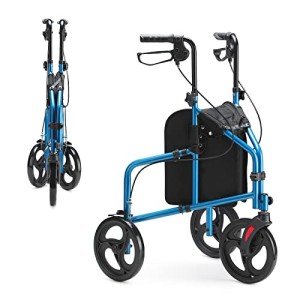
Sturdy Rollator
Add a review FollowOverview
-
Founded Date Agustus 21, 1988
-
Posted Jobs 0
-
Viewed 18
Company Description
The 10 Most Scariest Things About Medical Walker
Understanding Medical Walkers: A Comprehensive Guide
Medical walkers act as important mobility aids for people recuperating from surgery, handling persistent health problems, or dealing with age-related mobility problems. These gadgets not just improve physical self-reliance however also enhance safety, enabling users to navigate their environments with higher ease. This short article explores the types, benefits, features, and considerations related to medical walkers, along with some frequently asked concerns.
Table of Contents
- Types of Medical Walkers
- Benefits of Using a Medical Walker
- Key Features to Consider
- Regularly Asked Questions
- Conclusion
1. Kinds Of Medical Walkers
Medical walkers are readily available in various styles, dealing with various needs and choices. The main types include:
| Type of Walker | Description |
|---|---|
| Requirement Walker | A rectangular frame with four legs, offering stability and assistance. |
| Two-Wheeled Walker | Comparable to a standard walker however geared up with wheels at the front for easier movement. |
| Three-Wheeled Walker | A lightweight walker with 3 wheels, enabling more maneuverability, suitable for indoor use. |
| Rollator Walker | A walker with four wheels, hand brakes, and a seat, ideal for longer ranges and resting requirements. |
| Hemi Walker | Created for people who can use just one hand, including a tripod-like style. |
2. Benefits of Using a Medical Walker
Using a medical walker provides several benefits that contribute to the user’s overall well-being, consisting of:
- Increased Stability: Walkers supply a stable base of support, minimizing the risk of falls.
- Enhanced Mobility: They enable users to move around more quickly, promoting independence.
- Pain Relief: By rearranging weight, walkers can alleviate discomfort in the joints, especially in the hips and knees.
- Posture Support: These devices encourage proper posture, reducing strain on the back.
- Improved Confidence: Users typically feel more protected utilizing walkers, resulting in better self-confidence and increased activity levels.
3. Secret Features to Consider
When selecting a medical walker, it’s essential to examine numerous features to find the right fit. Here are some vital aspects to think about:
- Weight Capacity: Ensure the walker can support the user’s weight while maintaining stability.
- Height Adjustment: Look for a walker with adjustable height settings to accommodate the user’s height and provide comfortable grip.
- Material: Lightweight aluminum walkers are easier to maneuver, while steel walkers provide stronger support but might be heavier.
- Wheel Quality: If deciding for a wheeled walker, think about the wheel size and tread. Larger wheels navigate uneven surfaces more easily.
- Seat Availability: If users will be walking for longer durations, a walker with an integrated seat can offer rest breaks when required.
- Brakes: Hand brakes are particularly essential for safety in rollator walkers to control speed and stop when needed.
Kinds of Walkers with Features Comparison Table
| Walker Type | Weight Capacity | Height Adjustment | Wheels | Seat Available | Brakes |
|---|---|---|---|---|---|
| Standard Walker | Up to 300 lbs | Yes | No | No | No |
| Two-Wheeled Walker | Approximately 300 lbs | Yes | Yes | No | No |
| Three-Wheeled Walker | Up to 250 lbs | Yes | Yes | No | No |
| Rollator Walker | As much as 400 lbs | Yes | Yes | Yes | Yes |
| Hemi Walker | Approximately 250 pounds | Yes | No | No | No |
4. Often Asked Questions
Q1: Who should use a medical walker?A: Medical walkers are advantageous for people recovering from surgical treatment, experiencing balance problems, or needing assistance due to age-related mobility obstacles. Q2: Can a medical walker be adjusted?A: Yes, many

medical walkers are height-adjustable to accommodate various user heights, allowing for a more comfy grip. Q3: How do I select the ideal walker for my needs?A: Consider factors such as the
user’s weight, height, type of mobility concerns, and whether they need a seat or brakes. Evaluating the walker for comfort and stability before purchase is also suggested. Q4: Are there any safety ideas related to using a medical walker?A: Yes, users should ensure they don’t lean too
greatly on the walker, use it on stable and level surfaces, and always ensure
the brakes are engaged when seated or fixed. Q5: Can walking with a medical walker assist with rehabilitation?A: Absolutely. Medical walkers are often suggested as part of rehab programs as they encourage
physical activity, which aids in healing and mobility enhancement. 5.
Conclusion Medical walkers play an important role in boosting the lifestyle for individuals dealing with mobility challenges. With various types and functions offered, selecting the best walker includes thinking about the user’s particular needs and circumstances. By comprehending their benefits and correct use, people can restore self-reliance, improve their mobility, and browse their surroundings securely. Whether for short-term healing or long-lasting assistance, the ideal medical walker can substantially improve a user’s overall well-being. Including a medical walker into one’s day-to-day regimen can be a transformative decision, making it simpler to take part in life’s daily activities while making sure safety and confidence.